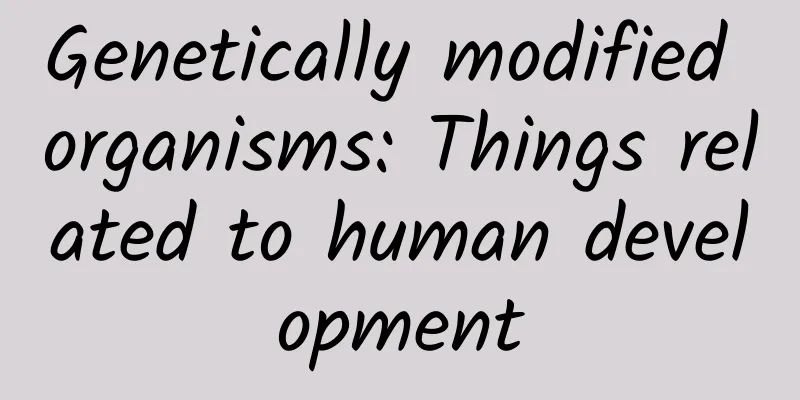Genetically modified organisms: Things related to human development

|
As human beings study life phenomena more and more deeply, they know that genes determine the characteristics of all living things. Genes, also known as genetic factors, are DNA fragments that carry genetic information. This invisible gadget is hidden deep in biological cells and determines the species of life and all phenomena such as birth, aging, illness and death. Genetic engineering is a process in which people, based on their understanding of genetic laws, use DNA recombination or gene splicing technology to construct hybrid DNA molecules in vitro from gene fragments from different sources according to a pre-designed blueprint, and then introduce them into the living cells of a certain organism, thereby changing certain genetic characteristics of the organism and obtaining new species that are better adapted to the environment or have improved quality. People call this process genetic modification technology. In fact, in addition to artificial genetic modification, nature has also been genetically modified. The deep-seated reason why all species on the earth have been evolving and changing is that they are constantly "genetically modified". Only changes in genes can bring about changes in species traits. In other words, if there had never been this kind of "genetic modification" in natural species, there would be no humans and all living things on Earth today. In this sense, genetic modification began 3.7 billion years ago. Genes have two characteristics: one is the ability to faithfully replicate themselves to maintain the basic characteristics of organisms; the other is the ability to mutate and transform, allowing organisms to continuously develop in a direction that is more adaptable to the environment. There are two types of mutations. One is pathogenic mutation, which accounts for the majority and can cause diseases such as cancer, and mainly occurs in individuals. The other is non-pathogenic mutation, which provides raw materials for natural selection, allowing organisms to select the most suitable individuals for the natural environment in the long-term evolution, which is a change in the species as a whole. The scientific community has not yet reached a definite conclusion on the origin of life on Earth. There are two main theories. One is that life originated on Earth, evolving from inorganic to organic to cells through chemical changes. The other is that life is an alien that came to Earth through meteorites, comets, and cosmic dust. Today we will not discuss the origin of life, but only talk about the history of biological evolution that has long been recognized by the scientific community. In March 2017, a research team from the University of London announced that they had discovered some tiny filaments, tubular particles and strip-shaped microbial fossils in the strip iron structure rocks in northern Quebec, Canada. These fossils were formed between 3.77 billion and 4.3 billion years ago and are considered to be the earliest and oldest life forms discovered so far. The age of the Earth is about 4.6 billion years, which means that life appeared not long after the Earth was born. Research suggests that these early primitive lives were invisible microorganisms that were born and lived in the deep sea. This is because when the Earth was first formed, there was no oxygen in the atmosphere and no ozone layer. The strong ultraviolet rays in the sunlight directly radiated to the surface, and life could not survive on land, but only in deeper sea water. The earliest life was the simplest single-cell prokaryotic life, and it was a heterotrophic anaerobic life form, which means it did not need or was even afraid of oxygen, and could not produce nutrients. It could only directly absorb organic nutrients from the environment to survive and reproduce. After hundreds of millions of years of adapting to the sunlight environment, life has evolved photosynthetic pigments and learned to use sunlight for photosynthesis. Although it is still a simple single cell, it has changed from heterotrophy to autotrophy. That is, through photosynthesis, it can convert inorganic substances in the environment into the nutrients it needs. This is a major leap for life. The metabolic waste of these organisms that can use photosynthesis is oxygen. The explosion of blue algae 2.5 billion years ago is considered to be the protagonist of the Great Oxidation Event on Earth. A large amount of oxygen changed the composition of the atmosphere, leading to the extinction of a large number of anaerobic organisms. Later, some aerobic organisms that adapted to the new atmospheric composition were bred and developed, and most organisms needed oxygen to survive. As the earth's environment changes, organisms have evolved from prokaryotic cells and single cells to eukaryotic cells and multi-cells, from aquatic to terrestrial, and from invisible microorganisms to visible plants and animals. These changes are not just changes in the appearance and functions of organisms, but are formed from the deepest genetic mutations, which are formed from long-term genetic mutations from generation to generation. Since the Cambrian period 540 million years ago, life has exploded in a visible form of diversity. Therefore, from then on, the Earth's evolution entered the Phanerozoic from the Hadean Eon, which shows the existence of life. During these 540 million years, life has experienced five mass extinctions and is now entering the sixth mass extinction. In each mass extinction, more than 80-95% of species have disappeared. There are about 8.7 million species of organisms on Earth, including microorganisms, plants and animals, about 6.5 million species of terrestrial organisms and about 2.2 million species of aquatic organisms. Since the emergence of life, at least 120 million species of organisms have existed on Earth, many of which became extinct due to their inability to adapt to the environment, and then gave birth to new organisms that are more adaptable to the environment. All species today, including humans and mosses and fungi, have evolved from the oldest and most primitive cell, and have reached where they are today through generations of genetic mutations. The genetic changes in natural evolution are to adapt to the natural selection process, with only slight changes each time, through continuous, gradual, beneficial, long-term countless generations of mutations and changes to the present. In contrast, genetic engineering is through artificial manipulation, mutations in one generation. But whether it is a slow and gradual natural change or an artificial mutation, it all falls into the category of "genetically modified organisms". And unless all animals and plants become extinct, natural genetic modification will always be on the way and there is no end. Modern genetic engineering is based on the understanding of the laws of nature and the use of them. Just like the evolution of nature, human civilization is also evolving, from the ancient ignorance to the ancient farming culture, and then through mechanization and electrification, and now entering the information and intelligent era. Humanity has moved from the darkness of ancient times to the light, from awe and passive obedience to nature to understanding the laws of nature and using them to actively transform nature. Science is leading humanity forward. Among them, the understanding of genetic genes not only allows humans to understand their origins and past, but also greatly changes the direction of human future. One of the greatest projects of the last century is the Human Genome Project, which is recognized by the scientific community as the moon landing project of life science. This project was proposed by American scientists in 1985 and officially launched in 1990. Scientists from the United States, Britain, France, Germany, Japan and my country jointly participated in this project. After 16 years of hard work and a cost of 3 billion US dollars, the last chromosome was sequenced in 2006. Chinese scientists participated in and completed 1% of the sequencing work, which was highly praised: China's bioindustry has entered the ranks of international leaders, shared all the results, resources and technologies of the Human Genome Project, and brought bright prospects for China's bioindustry in the 21st century. Once humans understand their complete genetic sequence, they will be able to overcome and change problems in their genes in a targeted manner, and through gene therapy and genetic drugs, make humans healthier and live longer. Genetic engineering is also called transgenic technology. The significance of this technology is to accelerate the genetic modification of organisms that has been slowly evolving for millions of years according to human wishes to serve certain needs. Now scientists are using this technology to benefit human society. Genetically modified technology has been widely used in the fields of medicine, industry, agriculture, environmental protection, energy, etc. internationally. For example, many of the widely used human insulin, recombinant vaccines, antibiotics, interferon, brewer's yeast, food enzyme preparations, additives, etc. are genetically modified products. In the agricultural field, a large number of new crop varieties with insect resistance, disease resistance, herbicide tolerance, stress resistance and high quality have been cultivated internationally, such as dozens of varieties of soybeans, cotton, corn, rapeseed, potatoes, apples, etc. At present, the global planting proportion of major genetically modified crops is 79% for cotton, 74% for soybeans, 31% for corn and 27% for rapeseed. The types of genetically modified products in my country are also constantly increasing. For example, the market share of domestic insect-resistant cotton has increased to more than 99%; three herbicide-resistant soybeans and four insect-resistant and herbicide-resistant corns have obtained production and application safety certificates; insect-resistant soybeans, drought-resistant corn, insect-resistant rice, drought-resistant wheat, and blue ear disease-resistant pigs have formed a tiered reserve. Some genetically modified foods with special effects can solve people's medical problems. For example, Swedish scientists implanted some genes from daffodils into rice genes, making the rice grown from these seeds contain more iron, thus solving the anemia problem caused by iron deficiency in 130 million people. Rice rich in carotene and vitamin A, commonly known as "golden rice", is obtained through genetic modification technology. The β-carotene content is 23 times that of ordinary rice. It can solve the problem of vision loss or even blindness caused by vitamin A deficiency in children. There are 400 million such children in the world. It can also solve the problem of malnutrition caused by carotene deficiency in children in many countries. Unfortunately, this research failed due to doubts and condemnations in China. It was later cultivated in the Philippines and approved for marketing. Data shows that there are about 70 million hepatitis B virus carriers in my country. In order to prevent the spread of this infectious disease, the country has developed a hepatitis B vaccine. In addition, the national "863" plan launched the "Use of genetically modified plants to produce oral hepatitis B vaccines" project. The project was undertaken by the Institute of Biotechnology, Chinese Academy of Agricultural Sciences, and successfully cultivated "hepatitis B vaccine tomatoes." It is said that this genetically modified tomato has obtained the production safety certificate of the Ministry of Agriculture and will soon be mass-produced and put on supermarket shelves. In this way, as long as you eat this delicious tomato regularly, you can prevent hepatitis B. Why not? Project leader Liu Dehu, a researcher, said in an interview with the media: As long as you eat this genetically modified tomato irregularly for a long time, you can keep the hepatitis B virus antibodies in your body at a high level. However, I didn't find any definite information about the final launch of this tomato, otherwise I would have liked to buy some to try. There are many such cases, such as making cow's milk rich in growth hormone through genetic modification; genetically modified soybeans that do not cause allergies; genetically modified fish that grow faster and have better meat quality, etc. These genetically modified products reduce labor costs in agricultural and animal husbandry production, reduce pesticide use and disaster losses, protect the ecological environment, improve food quality and nutritional value, and some can even solve human health and disease problems. So, are genetically modified foods safe? In fact, this question has been answered in the previous description. Because all natural products are the result of genetic modification, they are not the original ones. If everyone wants to eat the most original and natural products, then the only ones are the single-cell microorganisms 3.7 billion years ago. Not to mention the most ancient times, even 100,000 years ago, whether it was humans, pigs, dogs, cows, or rice, wheat, cabbage, or radish, they were not what they are now. They became what they are today after generations of gene mutations. Artificially changing genes is nothing more than people realizing the mystery of genes and making more purposeful changes. Humans ingest food mainly through the gastrointestinal tract to absorb the protein, fat, carbohydrates, dietary fiber, and sugar in the food. In all regular genetically modified foods, no matter how their genes or growth processes are changed, the nutritional content will not deteriorate but only improve. Therefore, foods obtained through genetically modified technology have nothing to do with food safety. Many people in society are wary of or opposed to genetically modified products, mainly because of instigation by some people, especially those who find some genetically modified technologies for pest control incredible. If insects don’t eat them, why can humans eat them? In fact, there are many things in the world that insects don’t eat but humans can, and there are also many insects that like to eat things that humans don’t eat. The reason why genetically modified insect-resistant crops can resist insect pests is that scientists have discovered that Bacillus thuringiensis can kill insects because this bacillus contains a special "Bt insect-resistant protein". However, this protein is highly specific in its insect resistance and is only effective against certain insects. For example, it will bind to the "specific receptors" on the intestines of "Lepidoptera" pests such as moths and butterflies, causing intestinal perforation and death. However, the gastrointestinal cells of humans, livestock and other non-Lepidoptera insects do not have "specific receptors" that bind to this protein. After entering the digestive tract, these anti-insect proteins are digested and degraded as ordinary proteins, and are just a form of nutrition. These have been confirmed in theory and countless experiments. These crops implanted with insect-resistant genes have fewer insect pests during their growth period, so no or very little pesticides are needed. As a result, the fruits will be fuller, more nutritious, and contain less harmful residues, which not only protects the environment but is also safer and healthier when consumed. Whether it is naturally grown food or artificially genetically modified food, the country has inspection standards. The inspection items are the nutritional elements contained in the food itself and the control indicators of toxic and harmful substances. As long as it meets the national food safety standards, it is safe food. No matter what kind of food, what is absorbed in the gastrointestinal tract is the digested nutrients, not genes. Some people get scared when they hear the word "gene", as if eating certain genes will affect them. According to this logic, people can't eat anything else, and can only maintain human genes by eating humans. In fact, we eat grains, pork, beef, mutton, chicken, duck, and chicken and duck eggs every day. These foods contain the genes of these animals and plants. We have eaten them for thousands and tens of thousands of years, and no one has ever turned into grains or animals such as pigs, cattle, sheep, chickens, and ducks. Why do so many people always fail to understand such a simple truth? Therefore, I hope that friends will not follow those who pretend to be asleep and serve some "organic" interest groups and make a fuss. Use your own brain to think about it, and you will understand. Of course, any science is a double-edged sword. Genetic engineering can benefit mankind, but it can also destroy mankind. Therefore, the safety of genetically modified foods that I mentioned earlier is based on the premise that genetically modified engineering must be carried out under national supervision, and all genetically modified foods on the market must be strictly inspected and safety certified by qualified institutions. Only then can such foods be safely consumed. Not long ago, scientists in Cambridge, UK, completed the decoding of the Arabidopsis gene map and found that after a long period of evolution, the plant itself contains almost all excellent genes, including genes for disease and pest resistance, high yield, deliciousness and high quality. This Arabidopsis has become the most widely used model plant in the world and is known as the "fruit fly in plants." This indicates that we only need to strengthen the excellent fragments in the plant's own genes and make them express more obviously and excellently during the growth process to get the desired results. In this way, in the future, plants using genetically modified technology may no longer need to be edited and implanted from genes of other species, and will be safer. Will such genetically modified foods still cause people's concerns and opposition? When I write articles like this, some people often shout in the comment section: Are you getting benefits by standing up for GMOs? Do you eat them yourself? I solemnly declare here: I have no contact with any GMO organizations or personnel. I am just speaking with the conscience and scientific common sense of a popular science person. When I buy food, I don’t pay special attention to whether it is GMO or non-GMO. The only criterion is cost-effectiveness. Of course, if there are genetically modified foods with special effects approved by the state and beneficial to my health, I will definitely buy and eat them. I have eaten many genetically modified foods, such as genetically modified cooking oil and soy products. I believe that everyone who has read my articles, whether you admit it or not, has eaten genetically modified foods, because all cakes and restaurants now may use genetically modified raw materials. Do you have the ability to refuse? Therefore, we should treat GMOs with a normal mind and live a happier life scientifically. What do you think about this? Welcome to discuss. Thank you for reading. The copyright of Space-Time Communication is original. Please do not infringe or plagiarize. Thank you for your understanding and cooperation. |
Recommend
Don’t celebrate too quickly. We are still a long way from proving room-temperature superconductivity.
Too long to read version: The successful reproduc...
Not all big blueberries are nutritious. Do you know which variety to look for?
Audit expert: Shi Jun Doctor of Botany, well-know...
3 data analysis tools you must know when playing Douyin: Use them to avoid many detours
To create a profitable Douyin account, in additio...
E-commerce poster design basics video tutorial
Course Description For many e-commerce designers,...
European and American automakers have successively slowed down their pace of electrification. Is it because they don’t want to, or because they really can’t?
Which industry has the largest "traffic"...
How to create a hit product on Xiaohongshu? Xiaohongshu’s hot-selling guide!
As a gathering place for the new generation of co...
Price positioning advantage no longer exists, mid-range joint venture car companies are under attack from all sides
There is a Hualian shopping center located on the...
With horns on the head and legs on the body, this mascot for the Year of the Snake actually makes sense?
Kind tips The pictures in this article contain sn...
In Chaoshan, why is “treating you to drink porridge” the highest treatment?
Loading long image... Source: China National Geog...
What does aerosol transmission mean? How many meters is the range? What are the differences from droplet transmission?
Droplet transmission, contact transmission, and ae...
Dragon Boat Festival holiday schedule 2022: How many days off? Is the highway free?
The Dragon Boat Festival, also known as the Duan ...
3 formulas for B station to become popular with over 1 million views!
A cool designer, a low-key female writer, and a r...
How can financial loans acquire customers through Tencent social advertising?
Under the influence of new consumption concepts, ...
Is there any pattern in the arrangement of galaxies, fractal or random?
Where do galaxies change and is there any pattern...
Double 11 "return": a secret battle between official event operations and private domain traffic
After the Double Eleven “100 billion” shopping ca...









